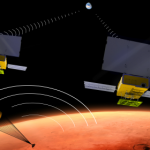InSight, the latest of the NASA space probes – a stationary lander built by Lockheed Martin Space Systems – that landed on Mars successfully earlier this week, marks a significant step for the global space industry in many ways[1]. A vista of entrepreneurial opportunities is likely to emerge, but first, its scientific implications are several.
InSight’s goal is very different from earlier Martian landers and rovers, such as the NASA lander Phoenix, and the rovers, Spirit, Opportunity and the large, car-sized Curiosity, which focused on analysing the geochemical composition of the Martian surface. Through InSight, scientists and engineers are seeking to better understand the geophysical processes occurring in the interiors of the Red Planet.
Mars’ geophysical constitution is a mystery even today: experts are still divided over whether four of the largest volcanoes of the solar system occurring on it are extinct or weakly active[2]. These volcanoes are indicators of the intense tectonic geological activity that occurred on Mars millions of years ago. InSight will prove to be an important mission in understanding the vital geophysical history of this once watery planet and whether it is inhabitable under the surface.
The mission will also be able to quantify the rate at which meteorites overcome Mars’ thinner atmosphere – as compared to Earth’s – before bombarding its surface. This information will have an important bearing on raising safer, meteorite-proof human outposts on Mars.
InSight is a major leap forward also in the use of miniature satellites for planetary exploration missions. Space exploration is a major driver of technology miniaturisation compromising on performance and output. The hitch so far was that cube satellites and the electronics within them were considered unfit to survive multi-month or multi-year interplanetary travel. This was because of their vulnerability to highly energetic particles of solar and cosmic origin that could have them malfunction. The fact that they endured the six-month voyage to Mars was revelatory for the scientific community.
The InSight mission consisted of two technology-demonstrator, communication-relay cube satellites (cubesats), together called Mars Cube One or MARCO. They weighed a mere 14 kg and were the size of a laptop[3]. The MARCO cubesats enabled faster confirmation of InSight’s landing on Mars than it would have been through the conventional Mars orbiting satellites, which have been large and capital-intensive. Cubesats are cheaper, they can be piggy-backed with the mother payload and can be used to create a mission-specific constellation or group of satellites, which enhances the productivity of the entire enterprise of planetary exploration.
The most important spin-off from using cubesats in Martian orbit is the continuous, low-latency or near-live communication possible between the ground control station on Earth and the robotic probes sent on Mars. Real-time communications between Earth and Mars will become an indispensable technology for human presence on Mars. Human-rated missions will also prompt the setting up of vast arrays of continuous weather and seismic monitoring sensors on Mars. The potential for the use of communication and Mars-orbiting-observation cubesats, and the miniature ground-based sensors will kickstart a major inter-planetary manufacturing, monitoring and communications industry. This is how it will happen.
Mars is the second-most visited planetary object, after the Moon, in the solar system. Its proximity to Earth, it being a terrestrial planet and its potential to host human habitations means that it will be visited even more frequently in the coming decades. The UAE, China, Japan, France, Germany and other European countries, part of the European Space Agency, are all preparing to launch their respective missions to Mars in 2020. The ExoMars is Europe’s first rover mission to Mars. China and the UAE will orbit Mars for the first time. Japan will land on it for the first time: these are not one-off missions, but constituents of these nations’ long-term ambitions to go to Mars.
More frequent visits by various countries, their agencies and private sector companies is therefore likely to generate contracts worth billions of dollars for building these sensors. Their transportation to Mars and the provision of the resulting big data from the sensors and communication gadgets will become a major Martian business. There will be a need for manufacturers who can build and maintain vast amounts of equipment and for monitoring companies that can sell the data generated.
The increasing human and robotic footprint on Mars is something that India should cash in on. It is a Mars-bound nation. It has gained initial success with the Mars Orbiter Mission and has a second one in the offing in the mid-2020s. It has proved its ability to launch hundreds of cubesats simultaneously, and its universities have demonstrated the creativity to build them for diverse purposes. New Delhi must see these accomplishments in totality and work to maintain its edge in the evolving interplanetary data industry.
Chaitanya Giri is Fellow, Space and Ocean Studies, Gateway House.
This article was exclusively written for Gateway House: Indian Council on Global Relations. You can read more exclusive content here.
For interview requests with the author, or for permission to republish, please contact outreach@gatewayhouse.in
© Copyright 2018 Gateway House: Indian Council on Global Relations. All rights reserved. Any unauthorized copying or reproduction is strictly prohibited.
References
[1] National Aeronautics and Space Administration, Federal Government of the United States, NASA InSight Lander Arrives on Martian Surface to Learn What Lies Beneath, 27 November 2018, <https://www.nasa.gov/press-release/nasa-insight-lander-arrives-on-martian-surface-to-learn-what-lies-beneath>
[2] Khayat, A.S., G.L.Villanueva, M.J.Mumma, and A.T.Tokunaga, ‘A search for SO2, H2S and SO above Tharsis and Syrtis volcanic districts on Mars using ground-based high-resolution submillimeter spectroscopy’, Icarus, Volume 253, 10 March 2015, pp. 130-141, <https://www.sciencedirect.com/science/article/pii/S0019103515000809>
[3] Jet Propulsion Laboratory, California Institute of Technology, National Aeronautics and Space Administration, Federal Government of the United States, Mars Cube One (MarCO), <https://www.jpl.nasa.gov/cubesat/missions/marco.php>


